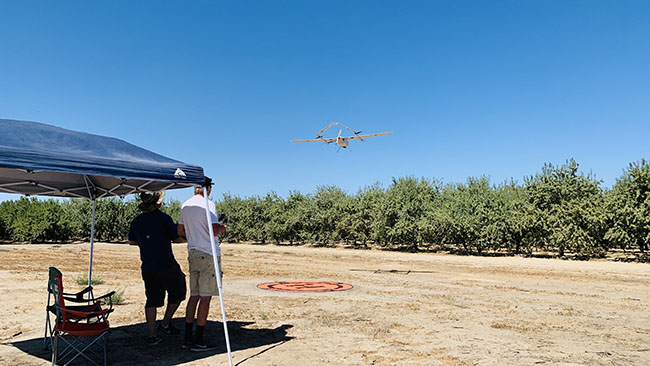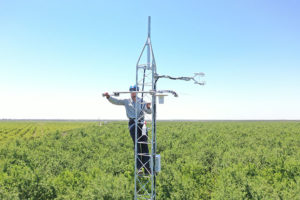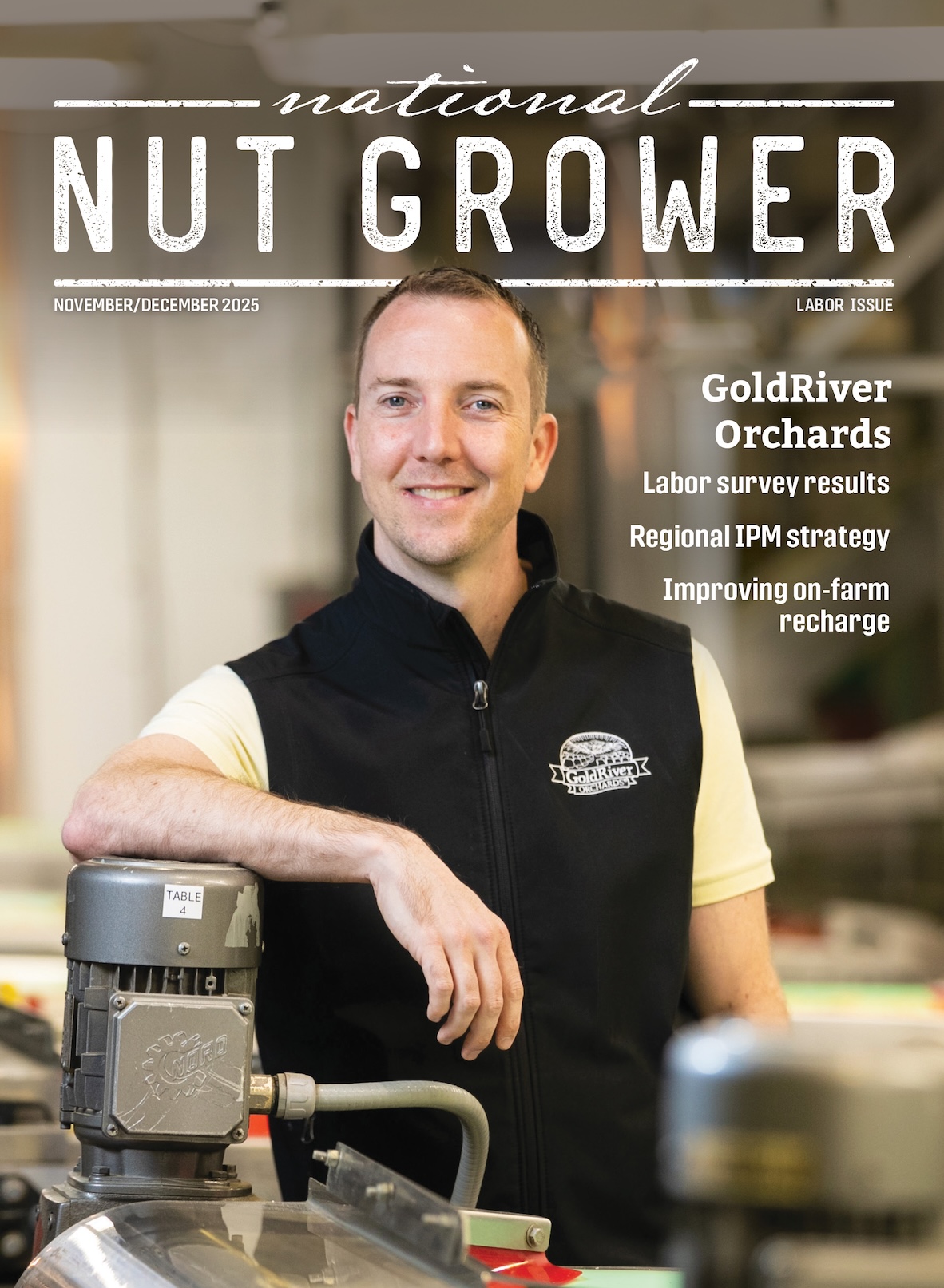
Winter 2022
Closing the gap
This information is part of the Tree Crop Remote Sensing of Evapotranspiration Experiment (T-REX) – a series of new, layered projects funded by the Almond Board of California and the California Department of Food and Agriculture, and in collaboration with University of California, Utah State University, and many other research and Extension experts.
Continued droughts in the West means that there has never been a better – or more important – time to optimize irrigation management.
Stem water potential (SWP) measurements using a pressure bomb are the current gold standard for assessing tree water stress and informing when to irrigate, including how long irrigation initiation may be delayed in the spring. There are also several tools available (e.g., CropManage, local ET reports) to estimate full crop evapotranspiration demand (ETc) based on empirical relationships between almond growth stages and the evaporative demand of the environment. Most growers or farm managers are undoubtedly familiar with the skills and labor that it takes to assess and interpret SWP measurements and integrate ETc into the irrigation schedules.
What if it could be automated even further? What if a grower could fly a drone to collect measurements of SWP or get daily estimates of actual ET at the tree scale using drones or satellite data? What if growers could save water by delaying irrigation initiation in the beginning of the season, and what if there were simpler ways to monitor stress responses to controlled deficit irrigation attempts at hull split?
Several new projects funded by the Almond Board of California and California Department of Food and Agriculture are coordinating to answer these questions across time and space using a variety of tools including drones, hyperspectral imagery, eddy covariance systems, and, of course, field-based observations and measurements of radiometric canopy temperature, stem water potential, photosynthesis and actual ET.

Cooperative Extension Advisor Luke Milliron and Orchard Systems Research Assistant Clarissa Reyes are testing several new almond varieties as well as conducting a delayed irrigation trial in collaboration with The University Farm at California State University, Chico. The Conservation Irrigation Lab is conducting aerial missions to try to understand how thermal imagery corresponds to differences in stem water potential throughout the field season, as well as differences in heat tolerance and drought resilience from the variety trial.
The team will also be working with Troy Magney to install a B.E.Y.O.N.C.E. (Breathing Ecosystem Y’all: Optical Near- surface Camera Equipment) tower to measure something called solar-induced fluorescence, which can be a very early indicator of plant water stress. Everyone involved is curious and excited to learn more about how they can use the best combination of tools to detect tree water stress before there are impacts to yield.
Additionally, by flying immediately before and after irrigation events, researchers will be able to separate long-term differences in tree water stress from any uniformity issues caused by irrigation applications.
Andrew McElrone’s research group installed an eddy covariance tower in partnership with KG Ranch in Ripperdan, California. This tower has instruments that measure different fluxes, which are parts of the energy budget. One type of flux is called the latent heat flux – think of this as a measurement of the energy that is transported to the atmosphere as water vapor from plant evaporation and transpiration. Once the latent heat flux is estimated in real time, we can use this value and the ‘heat of vaporization’ at a given temperature to convert it to a direct measurement of actual evapotranspiration.
This measurement tower has very high temporal resolution, as measurements are collected every 30 seconds. However, it does not have high spatial resolution, as measurements are made over a large footprint. The Conservation Irrigation Lab uses high spatial resolution multispectral and thermal imagery from commercially available sources to estimate both the latent heat flux and once again use the ‘heat of vaporization’ to convert to evapotranspiration.
The drone imagery provides a very high spatial resolution (24” pixel) measurement, but does not have high temporal resolution, as measurements are made as often as the lab can conduct a mission (~1-2 weeks). But, together with satellites, these two approaches will be used to develop and validate daily estimates of actual ET at the scale of a single tree. To develop these algorithms, the project’s researchers conduct intensive observation periods for one week each year in collaboration with Alfonso Torres-Rua from Utah State University, who has a custom fixed-wing drone. During these intensive observation periods, both commercially available and custom drones are flown five times a day and coordinated with satellite overpasses.

Drone camp for growers
Many growers express interest in – and even purchase – drones for experimentation with imagery. The problem is what to make of these pretty pictures. For growers with interest in drones for crop imaging, consider attending the University of California Agriculture and Natural Resources Drone Camp in summer 2022, which is targeted for people interested in using drones for agricultural applications. The program offers basic skills such as mission planning, photogrammetry, and tradeoffs between different drones, cameras and imagery acquisition/processing platforms. Mallika Nocco teaches workshops about both plant water stress and photogrammetry, and would be happy to see more growers at Drone Camp.
These research teams are attending and presenting some preliminary work at the annual Almond Board of California conference in December. They are friendly, so feel free to ask them about this work if you are headed to the conference.
Photo: Associate Professor Alfonso Torres-Rua’s Utah State team launches custom fixed-wing aircraft at KG Ranch field site during August 2021 intensive observation period. Photos: University of California and Utah State University









